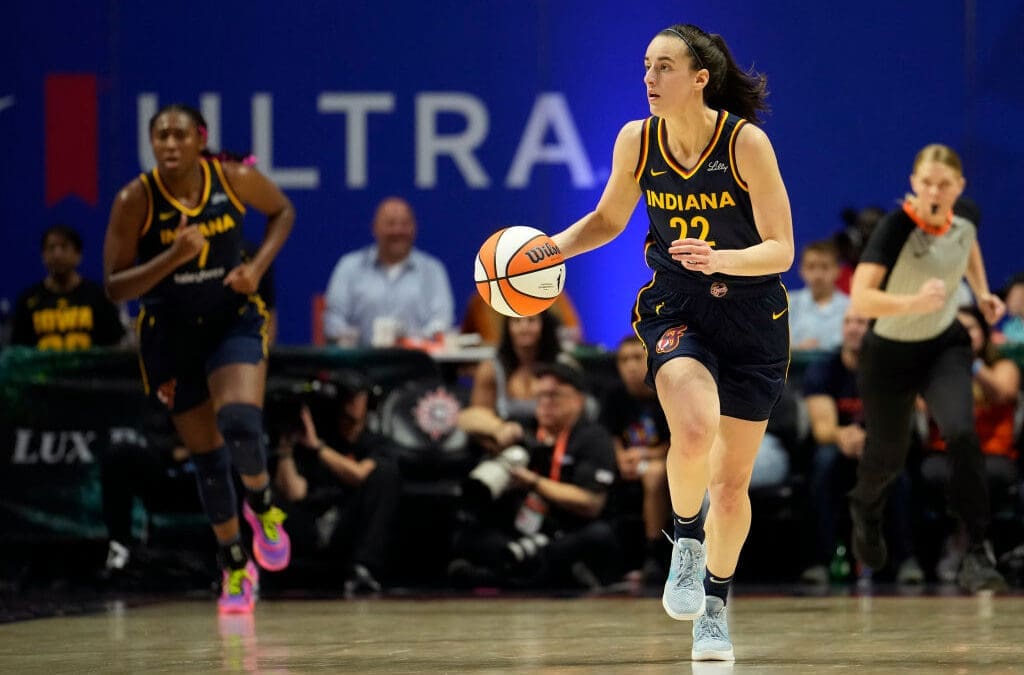
Now They Want to Charge Women With Killing Their ‘Preborn’ Babies
April 11, 2025
One Mom, Two Kids, and a Chronically Ill Husband: The Hidden Burden of Multigenerational Caregivers
April 11, 2025From early bans on competition to today’s media firestorms, women athletes still face outdated expectations to be fierce—but never too fierce.
University of Iowa guard Caitlin Clark stood at the free throw line and eyed the basket. It was March 3, 2024, and the 15,000 fans packed into Carver-Hawkeye arena grew quiet, watching expectantly. An astonishing 4 million more leaned towards their television screens.
As she had done so many times before, Clark raised the ball and flicked it towards the hoop. When it swished through the net, she became the all-time leading scorer in NCAA Division I basketball history. “Pistol Pete” Maravich’s record of 3,667 career points had stood for more than half a century—until a woman broke it.
The widespread acclaim accorded the hard-driving, trash-talking, fiercely competitive Clark would have been unimaginable in any other era of American history.
When American women first tried their hands at a new game known as “basket ball,” competitive sport was deemed the realm of men. Women, in contrast, were generally excluded from heated competition, and thus denied the right to claim the virtues associated with athletic success, among them discipline, determination, strength, stamina and assertiveness.
Opponents of female competition argued that women needed to be protected from its perils—protected from injury, from the public gaze, and from themselves, lest the “wild excitement,” “intoxication” and “nervous strain” of competition cause them to lose their self-control.
As sports became increasingly intertwined with success in fields such as business and politics, the exclusion of women from competitive athletics implied that they were not fit to participate in those arenas either.
None of this happened because women did not want to play, or to participate more fully in public life. Those links showed clearly in the fall of 1920, when a group of North Carolina high schoolers, encouraged by the passage of women’s suffrage, stepped onto the court.
“We elected ourselves to be the team,” player Mary Dalton explained decades later. “We had played together; we were friends. So we just decided we wanted to have a basketball team and we said: ‘We’ll be it.’”
Beneath their yearbook picture, the players proclaimed: “Man’s age has been heretofore, but now woman’s age is coming in, not only in politics but in athletics.”
Even as middle-class white communities and institutions discouraged competition, however, basketball thrived in areas outside that influence. In rural areas, working-class towns, Black neighborhoods and other communities, women were expected to be strong, and players had little trouble reconciling the exuberance of sport with other cultural demands.
Ruth Glover, who starred for all-Black Bennett College in the 1930s, summed up this approach: “We were ladies,” she told an interviewer. “We just played basketball like boys.”
Spurred by the women’s liberation movement, the passage of Title IX expanded sporting opportunities across the country.
Advocates had to fight hard for the resources required to turn that promise into reality, combatting persisting (and politically expedient) arguments that women were neither suited for nor interested in high-level competition. Step by step, supporters of women’s sport built a thriving athletic culture.
The work however, is far from over. Even as players such as Caitlin Clark and A’ja Wilson are widely celebrated, female athletes still contend with older, limiting ideologies.
The divide showed when Angel Reese made a triumphant gesture towards Clark after her LSU team beat Iowa for the national championship. The act drew a storm of criticism that would never have been leveled at a male player, reasserting strict constraints on female decorum—especially for Black women—and placing Clark in the role of victim.
Los Angeles Times columnist Mary McNamara deftly linked the furor to the broader significance of such double standards, referencing common critiques that women’s basketball wasn’t as “intense and entertaining” as men’s. “The first way to ensure women’s games aren’t as intense and entertaining is to publicly shame any woman who reveals the same kind of emotions or engages in the same kind of behavior that make men’s games so intense and entertaining,” she wrote. “The insistence that women act ‘nice’ or be ‘classy’ has kept women on the fringes of virtually every sphere of power in this country.”
In addition, the old specter of “protecting” women—especially white women—from physical harm has once again reared its head, most clearly in rifts about transgender women competing in women’s sports.
Questions of fairness aside, opponents of transgender women’s participation often focus on the need to “protect” young women from being harmed by transgender competitors, even though players are regularly injured in women’s sport, just as they are in men’s. Between 2012 and 2021, for example, more than 200,000 young women were taken to U.S. emergency rooms with volleyball injuries.
Such arguments—in sports and elsewhere—once again define women as naturally fragile and vulnerable, in need of protection “whether they like it or not.” The rhetoric of protection easily shades into portraying strong, independent women, among them Angel Reese and other WNBA stars, as outside the bounds of acceptable womanhood. It also limits all women.
Today’s athletic culture may well be strong enough to withstand these resurrected constraints, including revived attacks on Title IX. But the uneven course of women’s history makes it clear that gains cannot be taken for granted. The fight goes on.
Great Job Pamela Grundy & the Team @ Ms. Magazine Source link for sharing this story.







